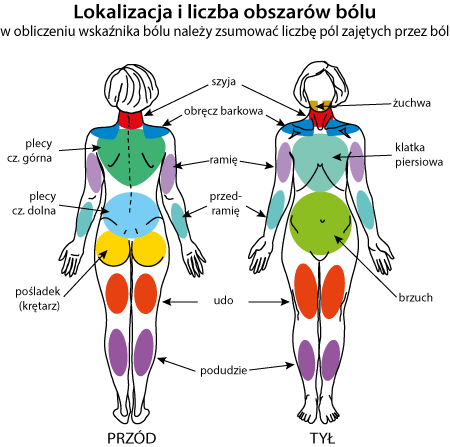Fibromyalgia – more common problem than it is believed
Fibromyalgia is a relatively poor known disease. However, it happens more often than one could think. Therefore, it is worth getting acquainted with this problem and finding out how to deal with it.
Fibromyalgia is a non inflammatory chronic rheumatic disorder. Main symptoms of fibromyalgia include widespread musculoskeletal pain accompanied by muscle and periarthritic tissue stiffness, chronic tiredness, insomnia or restless sleep, headache, depression, anxiety. Irritable bowel syndrome (IBS), overactive bladder (OAB), restless legs syndrome (RLS), Raynaud's syndrome are also often observed. Fibromyalgia syndrome is difficult to diagnose because of lack of unambiguous clinical criteria, lack of specific laboratory markers, lack of specific changes in imaging examinations (NMR, CT, X-ray, USG). Due to these facts the diagnosis of fibromyalgia is based on physician, rheumatologist most often, clinical experience.
─► Check if you may have fibromyalgia?
Diagnosis of fibromyalgia is difficult. It is based on diagnostic criteria of American College of Rheumatology (ACR)*:

One may diagnose adult fibromyalgia if hereiinafter criteria are fulfilled:
| Criteria (L/R — on left or/and right side) | Diagnosis (points sum) |
|---|---|
|
1. Widespread Pain Index (WPI)1 (score will be between 0 –19 points)
2. Symptoms Severity Score2 (score will be between 0 – 12 points )
|
Widespread Pain Index: sum of points ≥ 7 o r Widespread Pain Index: sum of points from 3 till 6 |
|
**Somatic symptoms to be taken into consideration when evaluating fibromyalgia intensity: muscle pain, irritable bowel syndrome, tiredness/fatigue, thinking and remembering problem, muscle weekness, headache, pain/cramps in the abdomen, numbness/tingling, dizziness, insomnia, depression, constipation, pain iin the uppper abdomen, nausea, nervousness, chest pain, blurred vision, fever, diarrhea, dry mouth, itching, wheezing, Raynaud's phenomenon, hives/welts, ringing in ears, vomiting, heartburn, oral ulcers, loss of/change in taste, seizures, dry eyes, shortness of breath, loss of appetite, rush, sun sensitivity, hearing difficulties, easy bruising, hair loss, frequent urination, painful urination, and bladder spasm. |
|

Besides above:
- Symptoms persist on similar level for at least 3 months
- There is no other pain causing disease.
- Fibromyalgia diagnosis is valid regardless of other diagnoses. Diagnosis of fibromyalgia does not exclude the presence of other clinically significant illnesses.
Here you may download questionnaire → new diagnostic criteria for fibromyalgia, (pdf file), that helps to calculate value of Widespread Pain Index (WPI) and Symptoms Severity score (SS score) and also might be helpful to find out probability if the fibromyalgia indeed might be responsible for your symptoms. The questionnaire has built-in sending function that could be executed if your computer has an active internet connection. You may send your questionnaire to our medical consultant if you want to get his opinion.
Caution: Make sure that filled up questionnaire is saved to hard disc of your own computer before sending. Give this file its own name, and send us such document. It is about saving the choices and data and/or not to lose or mistaken your document with other questionnaire that has identical name.
*ACR = American College of Rheumatology has redefinend new diagnostic criteria in 2010 fibromyalgia diagnostic criteria (pdf file, 11 pages in English).
1 Widespread Pain Index (WPI): Note the number areas in which the patient has had pain over the last week. One area = 1 point. There are 19 areas: 6 even and 7 uneven what gives 19 points in total.
2 Symptom Severity score (SS score): sum up presence and intensity. It could give up to 12 points together.
─► What to do if you think you may have fibromyalgia?
Diagnosis of fibromyalgia and planning of further actions has to be carried out by physician in every case. The active patient's particiation in this process is a key issue.

The diagnosis of fibromyalgia is difficult. It is believed that it takes five years in the USA from first symptoms to definite diagnosis. Patient with fibromyalgia is "not a favourite one" because establishing diagnosis and finding appropriate treatment is pretty time and cost consuming and the final therapeutic effect is quite insecure.
The process of a differential diagnosis has to be taken into consideration. The process of a differential diagnosis has to be taken into consideration. It is about to eliminate the illnesses that have symptoms that can resamble or even imitate fibromyalgia symptoms. Spondyloarthropathy, depression, and chronic fatigue syndrome belong particularly to such illnesses. However, if one takes into consideration diagnosis of fibromyalgia the further diagnostic steps should not be difficult. It is also important to find out whether other disease may accompany fibromyalgia. The physician experienced in fibromyalgia would be the ideal person to establish diagnosis and outline treatment plan. This will be most often rheumatologist in our circumstances.
Appropriate fibromyalgia treatment is an interdisciplinary medical approach. It is optimal and reasonable if in that process participate medical professionals of various specialities, chosen depending on individual course of disease:
| – rheumatologist | – family doctor |
| – neurologist | – psychiatrist |
| – rehabilitation specialist | – psychologist/psychotherapist |
| – orthopaedist | – dietician/nutritionist |
As in all chronic diseases patient education in fibromyalgia is very essential. It could be accomplished in schools for fibromyalgia patients that are recently formed. The patient has to be an active part of the effective treatment. Therefore education is so important. Aggravation or intensity of majority of symptoms in fibromyalgia is subject for individual and subjective patient's evaluation. Therefore patient has to "judge his own case" evaluating treatment effects. It s about to eliminate unnecessary or even harmful elements from therapy and focus on these that are according to his/her own evaluation are helpful and valuable. Cryotherapy might be a good example. It helps in some cases and could be harmful in another. This why treatment has to be individually tailored.
It is important that the patients, their relatives and families are organized in so called supporting groups. One can read more about that in the sections fibromyalgia treatment and Where I can get some help, Where I can get some information and on our internet service fibromyalgia.zone.
 |
for dietetic treatment in fibromyalgia |
The underlying cause of FMS remains unknown, therefore there is no casual treatment of this disease. The applied therapy aims alleviation of symptoms and improvement of quality of life mainly. The painkillers are ineffective in vast majority of cases.
Patients should actively look for appropriate and effective treatment and find optimal live style due to the fact that fibromyalgia has individually varied and complex outcome. It is usually a combination various therapies and modification of lifestyle. There are different medical professionals, family members, and support groups engaged in this process.
It is worth to try Myalgan or proMyalgan, preparations that have been specialy designed for fibromyalgia patients at Irvine University (California, USA). This purely natural formula provides nutrients that activate body’s own ability to effectively and fast combat fibromyalgia related symptoms; even if disease lasts several years. Many physicians recommend Myalgan and proMyalgan because both are completely safe and many patients report betterment. These OTC preparations are available in pharmmacies and health food stores. If you wonder what to choose – Myalgan or proMyalgan → see what are the differences.















